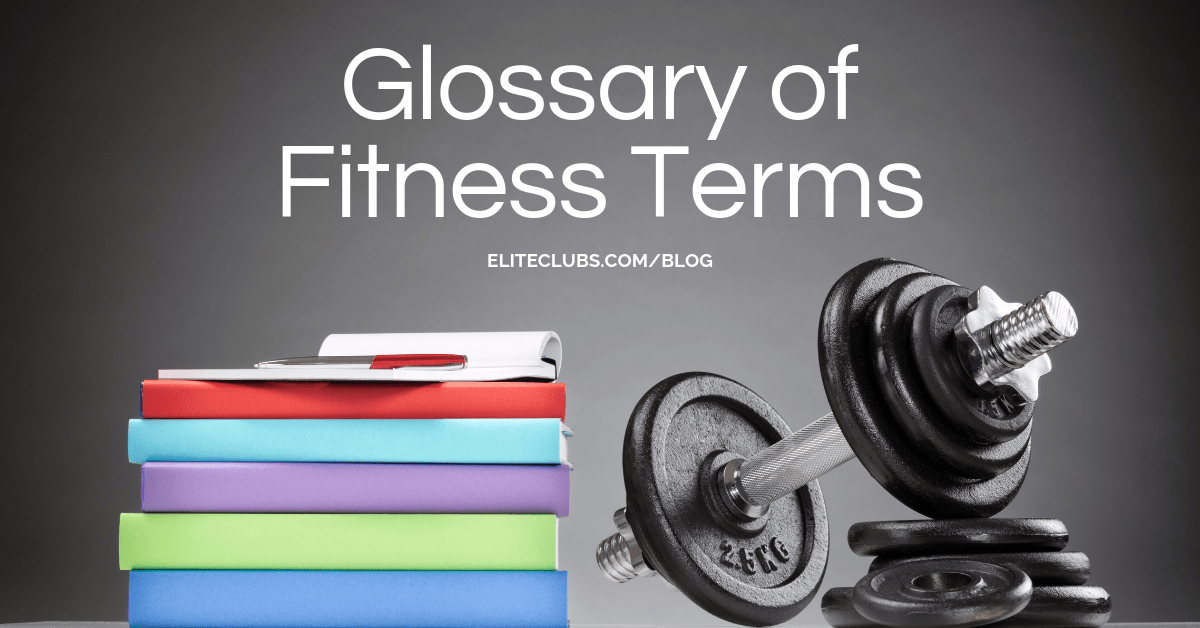
There are a lot of terms thrown around in a fitness setting. You’ll hear these industry words used by personal trainers, group exercise instructors, nutrition coaches, and see them appear in many fitness-related blog posts. We’ve come up with a handy fitness glossary you can refer to if you’re unsure of what certain terms mean.
Glossary of Fitness Terms
Active Recovery – General light activity used to lower your heart rate after a heavy workout.
Aerobic Exercise – Low to high intensity exercise designed to improve the body’s efficiency of using oxygen to meet energy demands. Also known as cardio exercise. Includes activities such as cycling, running, walking, and swimming.
Anaerobic Exercise – Short intervals of high intensity exercise where your body uses glucose for energy, because it cannot deliver oxygen fast enough.
Balance – The ability to maintain body equilibrium while standing or moving.
Basal Metabolic Rate – The amount of calories needed to keep your body functioning at rest.
Body Composition – The amount of body fat compared to fat-free mass such as bone, water, organs, and tissue.
Body Mass Index – A way to measure body fat based on height and weight. Because muscle weighs more than fat, BMI may not accurately indicate proportions of body fat.
Cardiovascular Exercise – Also see Aerobic Exercise.
Circuit Training – A series of exercise stations, such as balance or strength, with brief resting intervals between each station.
Concentric Phase – When your muscle is exerting force (such as lifting weights), this is the phase during which your muscles shorten (contract).
Cool-down – Light activities that gradually lower your heart rate and body temperature after moderate to intense exercise.
Core – The muscle group that is comprised of the abdominals, obliques, hips, and lower back.
Delayed Onset Muscle Soreness (DOMS) – The stiffness and achy feeling in your muscles several days after a strenuous or unaccustomed workout. When you exercise your muscles, you’re doing small damage to the muscle fibers known as microtrauma. The soreness you feel is the muscle’s adaptation in order to prevent further damage.
Dynamic Stretching – Stretching exercises that are performed with movement. In other words, the individual uses a swinging or bouncing movement to extend their range of motion and flexibility.
Eccentric Phase – When your muscle is exerting force (such as lifting weights), this is the phase during which your muscles lengthen.
Endorphins – hormone produced by the nervous system when the body undergoes pain or stress (such as exercise). They create a sense of euphoria, such as a “runner’s high.”
Foam Rolling – A self-myofascial release technique that utilizes a cylindrical tube made of compressed foam in order to release muscle or nerve tension/pain.
Flexibility – A measurement of range of motion (how far you can move) at a particular joint.
Functional Strength – The strength needed to perform activities of everyday living. For example, getting out of bed requires basic core strength to roll and turn, swing your legs off the bed, and then stand. Walking requires leg strength to move and maintain balance.
Heart Rate Zones – Target ranges expressed as percentages of your maximum heart rate. Training in certain heart rate zones will enable you to achieve various fitness goals. Training at 60-70% of your maximum is considered the “fat-burning zone.”
High Intensity Interval Training (HIIT) – One of the most effective forms of exercise to burn fat, this involves short bursts of high-intensity exercise followed by short periods of rest.
Isometrics – Exercises that cause muscles to exert force from static positions, rather than a range of motion. Muscles do not change length during contraction.
Low-Impact Exercise – Any activity that minimizes the amount of stress put on your joints. Examples include swimming, elliptical, and cycling.
Plateau – A point where progress flattens out during your regular fitness routine. This could apply to muscle gain, weight loss, endurance training, etc.
Plyometrics – Exercises that cause muscles to exert maximum force in a short amount of time. Commonly referred to as jump training.
Progression – An increase in the intensity, frequency, and/or duration of any physical activity over a period of time.
Reps – The number of times you perform a specific exercise.
Resistance Training – Exercises where your muscles contract against any external force, such as bands, dumbbells, or your own bodyweight with the intention of toning, strengthening, or building muscle mass. Also see Strength Training.
Resting Heart Rate – The number of times your heart beats per minute while at rest. Generally speaking, the lower your resting heart rate, the greater your cardiovascular fitness. A typical RHR is around 60-100 for adults according to the AHA.
Sets – A group of consecutive repetitions.
Static Stretching – Stretching exercises that are performed without movement. In other words, the individual holds a stretch position for a specific amount of time.
Strength Training – A type of physical exercise specializing in the use of resistance to induce muscular contraction, which builds the strength, anaerobic endurance, and size of skeletal muscles.
Watts – A measurement of the power you are producing and a way to evaluate the intensity of your exercise. It is how much energy needed to overcome inertia and make things move, like pedaling your bike, climbing stairs, powering the elliptical, or even running on a treadmill.
VO2 Max – Also known as Maximal Oxygen Consumption, VO2 Max is the maximum amount of oxygen your body can use during exercise. It’s used as a reflection of your cardiorespiratory fitness. Factors such as age, sex, fitness and training, and altitude can affect your VO2 Max.
If you’d like additional information about any of these terms or have a question about something not on this list, set up a meeting with a personal trainer!
Set up a Free Fitness Consultation